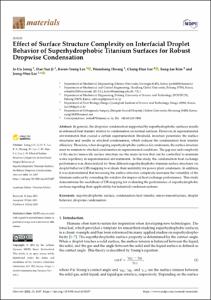Effect of Surface Structure Complexity on Interfacial Droplet Behavior of Superhydrophobic Titanium Surfaces for Robust Dropwise Condensation
- Title
- Effect of Surface Structure Complexity on Interfacial Droplet Behavior of Superhydrophobic Titanium Surfaces for Robust Dropwise Condensation
- Author(s)
- Jeong, Je-Un ; Ji, Dae-Yun ; Lee, Kwon-Yeong ; Hwang, Woonbong ; Lee, Chang-Hun ; Kim, Sung-Jae ; Lee, Jeong-Won
- DGIST Authors
- Jeong, Je-Un ; Ji, Dae-Yun ; Lee, Kwon-Yeong ; Hwang, Woonbong ; Lee, Chang-Hun ; Kim, Sung-Jae ; Lee, Jeong-Won
- Issued Date
- 2021-08
- Type
- Article
- Author Keywords
- Condensation heat transfer ; Droplet behavior ; Dropwise condensation ; Micro-nanostructure ; Superhydrophobic surface
- Keywords
- Super-hydrophobic surfaces ; Titanium surfaces ; Condensation ; Drops ; Energy efficiency ; Heat exchangers ; Heat transfer ; Mapping ; Superhydrophobicity ; Surface properties ; Surface structure ; Titanium ; Condensation heat transfer ; Dropwise condensation ; Enhanced heat transfer ; Heat exchange performance ; Power plant condensers ; Structure complexity
- ISSN
- 1996-1944
- Abstract
- In general, the dropwise condensation supported by superhydrophobic surfaces results in enhanced heat transfer relative to condensation on normal surfaces. However, in supersaturated environments that exceed a certain supersaturation threshold, moisture penetrates the surface structures and results in attached condensation, which reduces the condensation heat transfer efficiency. Therefore, when designing superhydrophobic surfaces for condensers, the surface structure must be resistant to attached condensation in supersaturated conditions. The gap size and complexity of the micro/nanoscale surface structure are the main factors that can be controlled to maintain water repellency in supersaturated environments. In this study, the condensation heat exchange performance was characterized for three different superhydrophobic titanium surface structures via droplet behavior (DB) mapping to evaluate their suitability for power plant condensers. In addition, it was demonstrated that increasing the surface structure complexity increases the versatility of the titanium surfaces by extending the window for improved heat exchange performance. This study demonstrates the usefulness of DB mapping for evaluating the performance of superhydrophobic surfaces regarding their applicability for industrial condenser systems. © 2021 by the authors. Licensee MDPI, Basel, Switzerland.
- Publisher
- MDPI AG
- Related Researcher
-
-
Lee, Chang-Hun
- Research Interests Structure-Function relationship of cytoskeletal proteins and membrane proteins; Structure-based design of biomolecules and drugs; Development of drug delivery system in skin
-
- Files in This Item:
-
 기타 데이터 / 1.37 MB / Adobe PDF
download
기타 데이터 / 1.37 MB / Adobe PDF
download
- Appears in Collections:
- Department of New Biology Biointerface Structure and Skin Lab 1. Journal Articles



